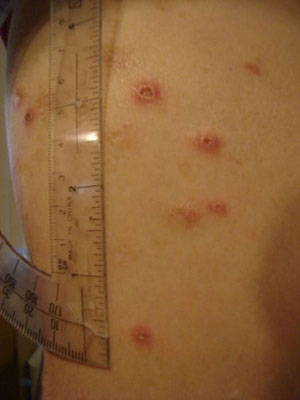
Newswise — A new finding out in the December 1st issue of Genes & Development offers insight into a new treatment avenue for two painful inflammatory diseases: Crohn’s Disease and sarcoidosis.
While the loss of NOD2, the gene studied in the provoking article, increases the risk of developing Crohn’s disease, increased activity of this gene is also thought to exacerbate symptoms. Additionally, activating NOD2 mutations can cause genetic sarcoidosis – an inflammatory disease affecting multiple organs in the body, but primarily the lungs and lymphoid tissue. A Case Western Reserve University School of Medicine research team has identified two existing FDA-approved drugs that are able to inhibit the activity of NOD2’s binding partner, the kinase RIP2, and therefore, also inhibit the activity of NOD2. by inhibiting NOD2’s signaling pathways through the use of medications, patients with these diseases potentially have a new avenue of treatment.
Over the past decade, drugs targeting protein kinases have been among the most successful pharmacologic agents developed in the treatment of both solid and blood-based cancers. Two of these medications, Tarceva® and Iressa®, target the cancer cells’ epidermal growth factor receptor (EGF-Receptor) protein kinase to inhibit the growth of both lung cancer and brain cancer. At Case Western Reserve, Drs. Justine Tigno-Aranjuez and Derek Abbott screened known tyronsine kinase inhibitors and found that these two drugs are very potent against RIP2. the researchers discovered that the medications target RIP2 as efficiently as they target the EGF-Receptor. the study further shows that both Tarceva and Iressa both inhibited and diminished the effects of NOD2 hyperactivation.
A difficult step in drug development centers on demonstrating the safety and efficacy of a new drug and ultimately having that drug approved by regulatory agencies. Tarceva and Iressa have been through the clinical regulatory process and have attained FDA approval. Therefore, this opens a door for treatment that, with appropriate preclinical testing for this new function, could be more rapidly translated into clinical treatment. although preliminary, this work suggests that these FDA-approved drugs may benefit conditions exacerbated by NOD2 hyperactivation, including sarcoidosis.
“While these findings offer a potentially beneficial avenue for the treatment of two serious inflammatory diseases, further testing is necessary to substantiate our initial promising findings. further testing is also necessary to validate the safety and potential efficacy of these agents in both Crohn’s disease and sarcoidosis,” states Derek Abbott, MD, PhD, assistant professor of pathology at Case Western Reserve School of Medicine and senior author on the study. “However, these studies also show that very basic biochemical research can lead to findings that could have clinical impact.”
In addition to identifying FDA-approved drugs that target the NOD2:RIP2 pathway, this finding also has implications for personalized medicine. “Like many cancer chemotherapeutics, Tarceva and Iressa cause side effects in cancer patients, including skin rash and diarrhea. it would be interesting to determine if these side effects change as a function of a patient’s NOD2 status and if the dosing needs to be adjusted in patients with mutant NOD2 versus those with normal NOD2,” says personal health expert Kathryn Teng, MD, director of Clinical Integration of Personalized Healthcare at Cleveland Clinic and assistant professor of medicine at the Cleveland Clinic Lerner College of Medicine of Case Western Reserve University. “Although these results are very preliminary in terms of patient care, their implications for personalized medicine are intriguing and might give a wide variety of reasons to test for NOD2 mutation status in a broader subset of patients.”
With an eye toward this future clinical development, Dr. Abbott’s team is working with the university’s Technology Transfer Office and pharmaceutical companies to further test the clinical potential of their findings.
This study was funded, in part, by grants from the National Institutes of Health and the Burroughs Wellcome Foundation.
About Case Western Reserve University School of Medicine Founded in 1843, Case Western Reserve University School of Medicine is the largest medical research institution in Ohio and is among the nation’s top medical schools for research funding from the National Institutes of Health. the School of Medicine is recognized throughout the international medical community for outstanding achievements in teaching. the School’s innovative and pioneering Western Reserve2 curriculum interweaves four themes–research and scholarship, clinical mastery, leadership, and civic professionalism–to prepare students for the practice of evidence-based medicine in the rapidly changing health care environment of the 21st century. nine Nobel Laureates have been affiliated with the school of medicine.
Annually, the School of Medicine trains more than 800 MD and MD/PhD students and ranks in the top 20 among U.S. research-oriented medical schools as designated by U.S. News & World Report “Guide to Graduate Education.”
The School of Medicine’s primary affiliate is University Hospitals Case Medical Center and is additionally affiliated with MetroHealth Medical Center, the Louis Stokes Cleveland Department of Veterans Affairs Medical Center, and the Cleveland Clinic, with which it established the Cleveland Clinic Lerner College of Medicine of Case Western Reserve University in 2002. casemed.case.edu.
Comment/Share